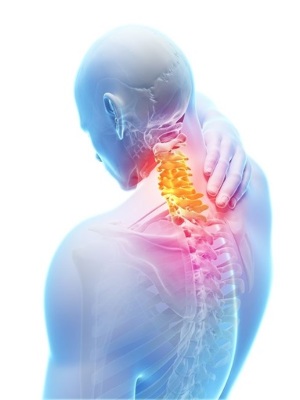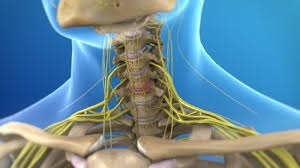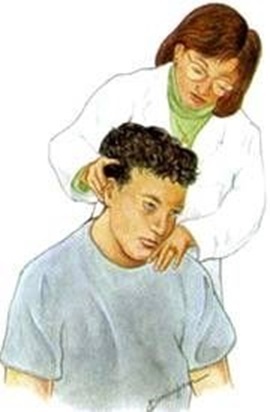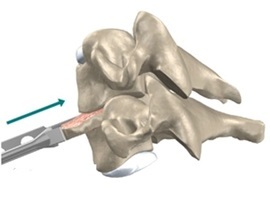Degenerative disc disease (osteochondrosis) in the cervical region of the spine is the main cause of the pain manifestations in the neck and irradiiruet pain in the hands. The events begin to occur in the case where one or more intervertebral discs in the cervical spine begin to deteriorate because of the degeneration.
The predisposition of certain individuals to the development of degenerative disc disease, perhaps, has a genetic component. The trauma can also accelerate and sometimes trigger the development of degenerative changes of the cervical spine.
The treatment of degenerative disc disease of the cervical spine gives good results when it has a lawful nature and is consistent and systematic. Osteochondrosis of the cervical spine is included in the list of the most common reasons of symptomatology among patients of working age, which has long sat in front of the computer. Often, patients do not pay attention to the pain and do not seek treatment , which leads to complications.
Risk factors for degenerative disc disease of the cervical spine

While almost all people sooner or later develop involyutsionnie degenerative changes of the cervical spine, there are certain factors that can make it more likely the early development of degenerative disc disease or the appearance of the symptomatology. These risk factors may include:
- Genetics. Some twin studies show that genetics plays a large role, that the way of life, in the early development of degenerative disc disease of the cervical spine and rapid onset of the symptomatology.
- Obesity. The weight is associated with the risk of the development of the disease degenerative disk (arthritis).
- All. This habit can prevent the entry of nutrients in the discs and accelerate their hydration.
- In addition, the trauma of the spine can sometimes start or accelerate the process of degeneration of the cervical spine.
The symptoms
The symptoms of degenerative disc disease of the cervical spine can widely vary depending on the individual.
When osteochondrosis is symptomatic, the pain may develop gradually or appear suddenly. The symptoms can vary from a certain discomfort in the neck up debilitating a sharp pain radiating to the arm, numbness and / or muscle weakness.
Main symptoms:
- Pain in the neck. Low-intense pain on the bottom of the stiffness in the neck is the most common symptom of degenerative disc disease of the cervical spine. However, sometimes, the pain can significantly increase and last for a few hours or a few days.
- Neuralgia. This type of pain tends to be acute, or with the sensation of shock to the shoulder to the hand and / or fingers. Typically, the neuralgia is felt on only one side of the body.
- The neurological symptoms in the hand, in the hand and / or fingers. Can produce sensations of tingling, needles, numbness and / or weakness that may spread to the whole of the upper limb. These types of symptoms can interfere with daily activities, for example, print, dress, or hold objects.
- The pain increases with movement. In general, the pain caused by a degenerative disease of the disk, generally, enhanced by the movement and decreases with rest.
- If the pain is coming from the degenerative disc, it is likely to disappear of itself for several weeks or months. However, other symptoms of degenerative disc disease of the cervical spine are often chronic and require treatment, for example, if facet joints in the neck also begin to degenerate and / or to compression of the nerve root.
Less common symptoms
More the cervical spine degenerates, the more likely it is that the vertebral canal is reduced and increase the risk of compression of the spinal cord. If occurs the compression of the spinal cord , will develop myelopathy, and symptoms appear such as:
- The difficulty of movement of the hand and / or feet
- Problems of coordination and / or balance
- The loss of control of the bowel and / or bladder
- The weakness and / or numbness anywhere below the neck
- Shooting pain in the limbs, which may increase the inclination of the front
Myelopathy cervical is a serious condition that requires immediate medical care. Usually, this condition occurs in people over the age of 50.
The diagnosis
The diagnosis of degenerative disc disease of the cervical spine can be established on the basis of these data:
- The medical history. First of all, the doctor needs to study in detail the symptoms and the history of the disease.
- The physical examination. Then, the doctor will conduct a physical examination, the edp and the neck and checking the range of motion in the neck. During the test patients can be prompted to perform a certain movement, and to report increases or decreases the pain in the neck.
- If the pain is intense, or if there are neurological symptoms, such as pain, tingling, or weakness in the arm, hand or brush, and then the doctor, most likely, assign to the achievement of the medical imaging .
- The methods of medical imaging (x-ray, ct, MRI, PET). If the doctor determines that to determine the precise genesis of the symptoms, you need to obtain images of tissues (rom) so, probably, will be assigned to the MRI. The MRI, x-ray or perhaps a ct scan can confirm if there are any signs of degeneration, as well as identify other state (such as osteoarthritis or stenosis), which can cause symptoms.
- After the confirmation of an accurate diagnosis of degenerative disc disease of the cervical spine, as well as all of the other members of the state, one can understand The genesis of symptoms and define a programme of effective treatment.
The state, associated with osteochondrosis of the cervical spine

The degeneration of disc is often accompanied by other pathological states that develop in either the same time or, in some cases, one thing leads to another. Most often the following states:
- The hernia in the cervical region of the vertebral column occurs if the degeneration of the disk leads to the violation of the integrity of the fibrotic ring and the pastor of content beyond the ring. But the herniated disc can occur after a trauma , that eventually accelerates the degeneration of the disc and causes the development of degenerative disc disease of the cervical spine .
- The cervical osteoarthritis. As the disk degenerates and the space inside the spinal column begins to decrease, facet joints may start to move abnormally and cause the wear and tear of the cartilage, as well as stimulating the formation of osteophytes in the cervical spine.
- The cervical stenosis of the spine. This is a condition that occurs due to osteophytes or herniated disc and occurs a narrowing of the spinal canal (where the spinal cord passes) or foraminal holes (where takes place the nerve root).
But you need to understand that sometimes, in some people, already at the birth of a narrowing of the spinal canal and the development of the symptomatology is not related to osteochondrosis.
Neuralgia cervical - the symptoms of pain, tingling, numbness and / or weakness, radiating in the shoulder to the hand and the brush, may occur when one or more nerve roots zaselyalsya or irritated. If when aortic stenosis occurs with compression of the spinal cord, herniated disc, or osteophytes, may develop a myelopathy. The possible symptoms of pain, tingling, numbness and / or weakness may be felt at this level in the region of the neck, and anywhere below the level of the compression. For example, in man may be tingling, or weakness in the legs, problems with balance or difficulty with control of bowel and bladder.
In case of any symptoms of myelopathy, it is essential to consult a doctor, because the condition may evolve, and without treatment can eventually develop paralysis of limbs and disturbances of functions.
Treatment
Generally, the onset of the symptomatology related osteochondrosis of the cervical spine was undertaken of therapeutic actions aimed at reducing the symptoms. Primarily in the treatment of degenerative disc disease of the cervical spine using non-surgical methods of treatment.

In the rare cases where the pain and symptoms persist or worsen, despite several months of treatment, or if there is a risk of damage to the spinal cord, then the question on the operation.
The options of conservative treatment
For the treatment of pain in the neck is caused by osteochondrosis, the doctor usually recommends one or more of the treatment options:
- A holiday or a lifestyle change. Some actions may be more painful for the neck, for example, stretching of the neck, in front in the use of the computer. Abstinence or modification of certain activities for several days or weeks is usually reduces the pain. In addition, it is recommended to maintain a correct posture (instead of down when you're sitting or flexion of the neck towards the front when driving, etc). The consumption of healthy food, adequate hydration, and quitting smoking is also beneficial for the health of the disks.
- Treatment of the pain with the help of medications or injections. Some effects can give otc pain medication. If the intense pain, it may be system to a stronger analgesic, such as oral steroids or muscle relaxants or even to opiates.
Injections, such as facet injection, nerve or epidural caudal blockade. They may include an injection of corticosteroid in a certain structure to reduce the local inflammation:
- Caudal injections epidural
- Injection into facet joints
- Steels caudal epidural caudal steroid injection
- Transforaminal injections, epidural
- The blockade of the nerve root
- The blockade of the medial branches
- Ice and heat can be used in the treatment of degenerative disc disease of the cervical spine.
- PHYSIOTHERAPY. Most of the non-surgical program of treatment of degenerative disc disease of the cervical spine are included in the programs of exercises such as isometric and tensile strength .The selection of the year must pass by a qualified technician ( doctor of the CFL) , so that the lack of exercise can lead to a deterioration of the state . In addition ,the exercises must be chosen taking into account the individual characteristics of the individual . In general, the increase of the strength and flexibility in the neck area may reduce the risk of pain and, to a certain extent slow down the degenerative changes in the discs.
- The manual therapy. The cervical spine can be manually adjusted by a qualified technician in the field of health, to improve the range of motion and / or to reduce the pain. According to the symptoms of the patient, you must pass a physical examination and / or viewing prior to the manipulation with the hand in the neck.
- Physiotherapy
- Massage
- Acupuncture
- Corethrogyne
The surgical treatment of degenerative disc disease of the cervical spine
Operational modalities for the treatment of degenerative disc disease of the cervical spine is generally considered in two cases:
- Are present, the neurological symptoms such as numbness of the hands and / or weakness, or problems with walking or the control of the intestine. If the neurological symptoms caused by osteochondrosis of the cervical spine, there is a risk of irreversible damage to the nerves are to, and surgery may be recommended to reduce the pressure on the nerves are to the.
- The chronic pain is severe and cannot be treatment for at least six months of non-surgical treatment, and the daily activity is difficult. The best surgical results are intended for patients with chronic pain, in combination with other states, such as the instability motor segments of the neck and / or neuralgia.
The main surgical methods of treatment of degenerative disc disease of the cervical spine are:
- Before discectomy and cervical fusion (ACDF).
- Disc replacement artificial.
In addition, there are a number of other surgical procedures for the treatment of degenerative disc disease of the cervical spine:

- The endoscopic decompression
- Endoscopic is foraminotomy
- Percutaneous decompression
- Intra used disk electrothermal therapy
- Selective discectomy endoscopic
- The stimulation of the spinal cord
- Radiofrequency ablation
- Epidural lysis of adhesions
Surgical procedures on the neck, aimed at the decompression of the nerve root and / or spinal cord and, therefore, the reduction of neurological symptoms, such as pain or weakness, a tendency to a good far positive results are the forecast is 80% to 90% .
































